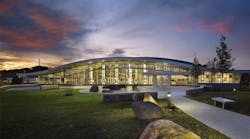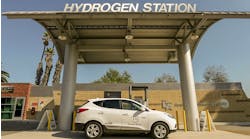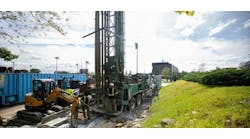When construction slows and campus operating expenses are under the microscope, it is more important than ever to save energy dollars with the equipment and staff on hand.
For the facilities manager who thinks out of the box, significant savings can be found on most school and college campuses. Some tips to consider:
-
Use the campus chilled/condenser water-distribution system to avoid peak charges
Look for large loads on campus, and develop ways to turn those loads off at the right times to reduce demand peaks. In some cases, this will have to be done manually, but sometimes it can be done with timers. Loads such as domestic hot-water heating and chilled-water production usually can be shifted by a few hours with no adverse consequences. Moving these loads to off-peak times can cut peak usage and lower energy bills.
-
Don't circulate for nothing
Many classroom buildings have very low hot-water usage, most requiring hot water only for restrooms and break areas. Yet, these spaces are provided with circulating hot water from a water heater/tank combination in the machine room in the building. Instead of this tank, pump and circulating system, consider the use of instantaneous point-of-use hot-water heaters at each sink. These units can come as small-tank assemblies that are safe and reliable, and take up only the space under the counter.
Energy is saved by not running the circulating pump, and by avoiding convection heat losses from the hot-water tank and hot-water supply and circulation lines. Another benefit is that stopping these sources of wasted heat reduces the heat load in the building and lowers air-conditioning costs in the summer.
-
Turn lights off (and equipment, too)
Lights that are turned off save energy and reduce the need for lamp replacement. Motion sensors turn lights off in unoccupied classrooms, restrooms and storage rooms, and timers turn lights off when auditoriums, libraries, gyms and lunchrooms are not scheduled. If a librarian must work when the library is closed, provide task lighting and shut the rest of the lights off. For open work areas, master switches connected to the main lighting panel enable the last person leaving to turn off all lights in the area. For large spaces with dedicated air-handling units, packaged AC units connect their power so that they are locked off when the lights in the space are off.
Janitorial use of lights at night costs a lot of money. Try to move more of the cleaning operations into daylight hours. Also, do not use the lights to signal which spaces have been cleaned by janitorial but not checked; this results in lights being on much of the night.
Common areas along building perimeters usually have plenty of daylight; photo-sensor-based light controls dim the electric lights when the sun is out. The same system can provide a selection of predefined light levels that suit needs from film screenings to silk screenings.
A daylight harvesting system can be beneficial. Installed in perimeter lighting zones, sensors automatically modulate lighting in response to the ambient light levels. These systems can be installed at modest additional cost when timed to coincide with a planned lamp change-out or ballast retrofit. Check with the local utility or state energy office to see if they provide matching funds.
-
Stop using the brakes and gas pedal at the same time
Many K-12 and college buildings built between the mid-1800s and the mid-1900s use steam perimeter heating and have been retrofitted with central air conditioning or window-mounted air-conditioning units. In many cases, the perimeter steam heating is heating the space while the air-conditioning units are trying to cool it. This inefficiency can be difficult to spot because the occupants may not be uncomfortable. The space simply will use 10 to 50 percent more energy than it should. The owner may finance an expensive window/roof retrofit when the solution could be a low-cost/no-cost operational change.
If building occupants are opening windows to cool spaces, the existing system may be overheating. If the perimeter system is steam, change it to water-based (hydronic) if the piping and heat transfer devices (fin-tubes, radiators) allow. Water is much easier to control and less likely to over-shoot the space temperature set point.
Consider installing an outdoor air-temperature sensor and using that signal to shut off all heat to the building when it gets warm outside. Experimenting with the shutoff point will enable the building heat to be turned off in mid-morning in many months of the year, saving a day's worth of wasted steam.
-
Commission existing buildings
Commissioning existing buildings (EBCx) reduces energy consumption while tuning up the health, safety and maintainability of a building. EBCx includes an energy audit that will generate savings from the "low-hanging fruit."
A recent Evan Mills Lawrence Berkeley Lab study, which included about 900 buildings across the United States, showed EBCx paybacks of a little more than one year. It also will help guide energy options for the long-term capital plan. Better than the traditional energy audit, EBCx provides "legs" for savings by including the retraining of the building's maintenance and operations staff and providing them with one-line diagrams and new M&O manuals that make troubleshooting problems and ordering new parts faster and easier.
Add the sub-metering and/or recordkeeping that is required for continuous monitoring of the building's energy use, and the campus will have another built-in alarm to notify the staff when something is wrong and money is being wasted.
Wilkinson, PE, CPMP, is commissioning project manager with AKF Group LLC, New York City, an engineering firm specializing in HVAC, electrical, commissioning, and other services. AKF was engineer of record and provided energy modeling for the Neumann University project. [email protected]
Related Stories
Sidebar: Demanding Savings
At The Evergreen State College, Olympia, Wash., the facilities-management staff dreaded every June. It was during that month that the chillers would have to be started for the first time in the year, and the college was faced with a multi-thousand-dollar demand charge.
Demand charges for power were based on the maximum current draw during any given month. It cost the college thousands to start a large chiller for an hour at 3 p.m. in June to cool the kitchen in the student commons, even though no place else on campus needed cooling.
The college found an answer in one of its utility tunnels. It could run the chiller at night, when there was no demand charge, fill the distribution piping with chilled water and cool the kitchen during June (and September) afternoons by running just the pumps. It no longer ran the chiller during peak daytime hours until the weather was hot outside all the time and the chiller had to run continuously. Learning how to make better use of what they already had saved thousands of dollars with zero capital investment.


